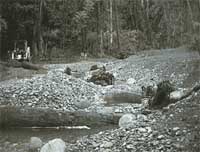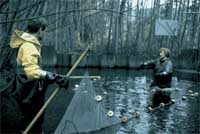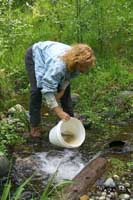|
Strandley Manning
 |
|
Reconfiguring the stream channel
|
Remedial activities at the Strandley/Manning Superfund site, near Washington State's Puget Sound, exemplify the benefits of cooperative, efficient integration of natural resource concerns early in the cleanup process. The sediments of a small stream were contaminated with PCBs from a transformer salvaging operation. The responsible parties, led by Seattle City Light, worked with EPA and NOAA ARD, to evaluate contaminant effects. This early cooperation led to an agreement to remove contaminated sediment and to restore the stream to a level of habitat capable of supporting native trout species.
 |
|
Collection of resident trout
|
NOAA ARD, coordinating with EPA and responsible parties, conducted field work and studies to evaluate whether chronic PCB exposure adversely affected cutthroat trout population residing in the stream. These studies concluded that contaminated sediments from the site significantly reduced survival of trout larvae; however, male fish from the site were able to reproduce successfully. NOAA also provided detailed technical support to EPA throughout the cleanup process to ensure that environmental issues were addressed. Information provided by NOAA ARD contributed to streamlined decisions and an efficient cleanup and restoration process.
Based on results of initial investigations and EPA's cleanup goals, the removal action was recently completed. Before the excavation of stream sediments, the resident trout were moved to an artificial pond nearby. Restoration efforts at the Strandley/Manning site included:
- Replacing stream gravels,
- Placing structures in the stream to stabilize the channel and provide pools for sheltering fish, and
- Planting riparian vegetation.
 |
|
Reintroduction of resident trout
|
Responsible parties are monitoring the site for restoration effectiveness. Early evaluations of sediment chemistry, vegetation coverage, stream flow, structural stability, water quality parameters, and invertebrate and fish populations indicate that the stream habitat could support fish. As a result, fish removed before cleanup in 1995 were reintroduced in May 2000 to their native stream to preserve the original genetic stock from the area and to allow them to return to their normal migratory and reproductive cycle. The cooperative monitoring of full success of the restoration of the stream to healthy aquatic system will continue over the next few years.
|


